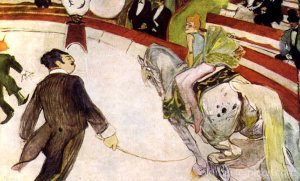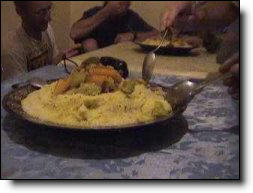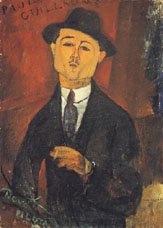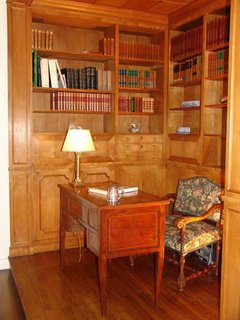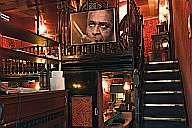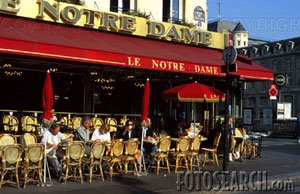So, here we are at the end of a long day of seeing the sights of Berlin. Why Berlin you ask?? Well, this was the only route available to get to Paris, Business Class, using air miles, so we decided to stay a couple of days. Like Paris and New York, Berlin is a great place to walk. Our hotel, the Ritz Carlton is on the Potsdamer Platz, formerly in ‘East Berlin’. East Berlin has been completely rebuilt in the last 10 years and this area, especially, is the site of new, very modern, skyscrapers. Opposite us is the fabulous Sony Center pictured above. It’s a maze of walkways, cafes, cinemas and shops.
Our arrival coincided with the Berlin Marathon which finished just down the road from our hotel. As a result, there was no car access and we had to schlep our suitcases (6 weeks of clothes!) through throngs of well-wishers to our hotel. However, right after we checked in we walked to the finish line area and rewarded ourselves with a glass of ‘Berliner Pils’ and a “wurst”. It always amazes us to watch older people complete a marathon looking less winded then we do after a 45 minute workout! They must have better trainers! It couldn’t be anything we do, or don’t do!
Berlin has changed overwhelmingly in the last 15 years. It was interesting to compare what we each remembered from previous visits (Paul’s last time here was 1976, mine in 1991)! When Paul was here, Berlin was a beleaguered city surrounded by East Germany. You needed a passport to visit the East and it was quite frightening to turn over your passport at “Checkpoint Charlie”. On your return, your car was searched for contraband (or people--who were routinely shot trying to escape). On one trip, Paul’s car was searched on the way in and his Hilton and Playboy magazines confiscated as forbidden propaganda. Paul was upset to see that the famous Church that had been preserved as a bombed hulk as a reminder of the war, had been repaired! It’s still called a memorial, but the roof has been closed in and the ceiling inside repaired (albeit poorly). Only the outside has been left alone. Preventing additional damage from the elements seemed like a poor excuse to drastically change a memorial like that. He thinks right-wing nationalists did it to eliminate one of the few remaining signs of the war.
Chris was here just after the wall came down. The East was a grim, rundown area with little business. Now, it’s the showplace of a proud German Republic with huge new government and private buildings. The government was moved here from Bonn, requiring a huge investment in offices and embassies. All is not perfect, however, the city still has an unemployment rate of 17% and is almost bankrupt from the social costs of supporting the social obligations of the East.
We only had one day to sightsee and took one of those split level busses around the city. One interesting thing that we saw was the new Memorial to the Jewish dead in Europe which was within walking distance of our hotel. It’s a field of hundreds of simple gray slabs of stone {looking like tombs) of varying heights (from flat to 10 feet high), arranged in rows, over rolling hills. You can walk between them but quickly lose sight of each other. It’s eerie, I had a moment of panic when Paul and I got separated—it’s not a place for little children. There are no names listed, nor is there much of a description to let you know where you are. Walking between the rows made people there very quiet. On another visit we plan to go into the underground museum that we missed this time. The ‘hop on’, ‘hop off’ bus tour allowed us to manage our whirlwind tour of the city; wandering around the Reichstag (government seat now), Checkpoint Charlie, the Brandenburg Gate, the Memorial Church and of course a stroll down the famous Ku’damm where we peeked into all the designer shops. We had a late afternoon coffee (which means cake is involved) in an outdoor café at the famous Kempinski Hotel. Here and there we saw pieces of the former ‘Wall’ and tried to imagine what it must have been like to live in a city divided.
While here, we wanted to stick to local ‘German’ food since we were heading to Paris for 6 weeks. That was easier said than done. Other than the traditional ‘wursts’ from street vendors and a Weiner Schnitzel at a pseudo-French brasserie we were unable to find any ‘better’ German restaurants – they were all French or Italian! The beer was good, the bread was better and I will miss the incredible yogurt bar at the hotel.
auf weidersein,
Christina & Paul
September 26, 2006

 I'm a real circus junky so when Irv and Iris recommended we go to "Le Cirque d'Hiver" I didn't miss a beat and reserved seats - front row and center - even though we weren't planning on kidnapping a little kid off the street to bring along! On the appointed day, there we were amidst a zillion kids (it's holiday week here), parents and sundry other folk.
I'm a real circus junky so when Irv and Iris recommended we go to "Le Cirque d'Hiver" I didn't miss a beat and reserved seats - front row and center - even though we weren't planning on kidnapping a little kid off the street to bring along! On the appointed day, there we were amidst a zillion kids (it's holiday week here), parents and sundry other folk. d of course, the clowns. We enjoyed everything. Chris was thrilled to be able to understand some of the jokes. We especially enjoyed a 'ventriloque' who made you think a live dog was talking and the juggler who worked with 6 white balls that he bounced on the floor so fast it looked like they were attached to strings. There were also two amazing Chinese 'equilabristes' who twisted their bodies into unbelievable shapes while they balanced on each other and twirled parasols and cloth disks from every part of their bodies. At one point one girl was bent over backwards on the floor on one foot and hand while spinning disks from the others. The other girl was standing on her hand on her hip while twirling disks from her other three extremeties. It was remarkable!
d of course, the clowns. We enjoyed everything. Chris was thrilled to be able to understand some of the jokes. We especially enjoyed a 'ventriloque' who made you think a live dog was talking and the juggler who worked with 6 white balls that he bounced on the floor so fast it looked like they were attached to strings. There were also two amazing Chinese 'equilabristes' who twisted their bodies into unbelievable shapes while they balanced on each other and twirled parasols and cloth disks from every part of their bodies. At one point one girl was bent over backwards on the floor on one foot and hand while spinning disks from the others. The other girl was standing on her hand on her hip while twirling disks from her other three extremeties. It was remarkable!